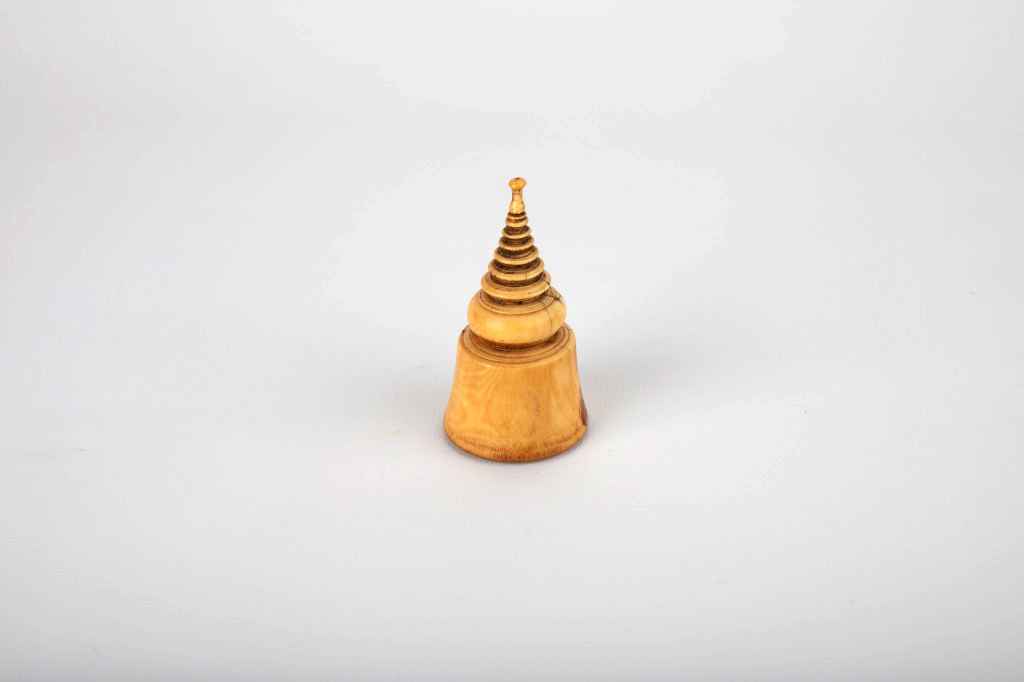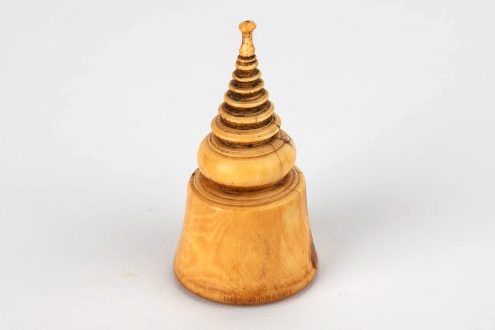Ivory Seal With a Design of a Reclining Elephant
Ivory Seal With a Design of a Reclining Elephant

Ivory Seal in Stupa Shape with a Stamp Design of a Reclining Elephant
Unknown artist
Ivory
2.75 x 1.5 in.
Thailand
1978.010
Carved from a simple piece of ivory, this seal takes a localized form of an archaic Indian-style stupa.1 The bottom stamp design features an elephant reclining on a podium, which is surrounded by classic Thai-style kranok, a flaming foliage motif. The surface bears dried seal ink, demonstrating a visible trace of past use.2
The stupa is a prominent feature of Buddhist monasteries, which are known by the name wat in Thailand.3 The wat acts as the center of the Thai community by serving as a religious center, school, health clinic, cremation ground, entertainment hall, and art repository.4 Central to the wat is the stupa which is typically characterized by one of two names – chedi, a stupa that holds a relic of a buddha, and that, which does not.5 As a result, the image of the stupa both appeals to the authority of the state through the multifaceted role of the wat in the Thai community and simultaneously references the body of the Buddha through the stupa reliquary’s possible function as a containment of his physical remains.

The relationship between state and religion can also be seen through the use of the white elephant motif on the bottom of the seal. The white elephant motif is commonly found in Buddhist legends, often symbolizes a Buddha-to-be, and is most famously found in the Vessantara Jataka which is an episode of the Jatakas, or tales of the past lives of the Buddha.6 In Thailand, the white elephant, or the chang phuket, symbolizes the universal monarch and was bestowed to kings as a symbol of strength and prosperity.7 The white elephant motif originally served as a reference to the body of the living Buddha (likely partially due to the tale of the historical Buddha’s conception) and was later incorporated into a political context as a means of royal legitimization.

In addition to the white elephant imagery, the seal itself is made of elephant ivory. In addition to the material connection to the represented imagery, local beliefs situate elephant ivory as able to warn off bad spirits, so it is often used to carve small talismans for personal use.8 As a result, elephant ivory was likely used with a similar intent of adding protection to documents approved by the authority of the seal.
In the 19th century, seals became prevalent in Thailand because a Royal Command required people to sign or put a seal on important documents.9 Both monks and government officials began to apply seals as a mark of identity and approval.10 By lending authority to secular documents, seals became symbols of power. This idea dates back to the 15th century when Ming Emperors conferred seals to the kings of Thailand as an endorsement of their authority.11 In 19th-century Thailand, Buddhism became a major source of royal legitimacy. As the founders of the Chakri Dynasty (1782-present) were not royal members, they sought legitimization from Buddhism by declaring themselves as bodhisattvas. The stupa shape of the seal epitomizes the power dynamics between Buddhism and royalty. By preserving relics and bringing them into the present, stupas serve as a tangible link to the Buddha’s presence. In this way, the form of stupa functions as an identifiable symbol of Buddha’s presence and power. By incorporating this form into seals, the designers identified Buddhism as the source of royal authority and employed concepts associated with relic practice within these types of objects.
Key Words: Seal; Ivory Carving; Thailand; Elephant Motif
Niya Burney
Economics & Mathematics
Class of 2023
Zane Sun
Mathematics & History of Art
Class of 2023
Annotated Bibliography
Bowie, Theodore Robert, and Alexander B. Griswold. The Arts of Thailand : Handbook of the Architecture, Sculpture, and Painting of Thailand (Siam), and a Catalogue of the Exhibition in the United States in 1960-61-62. Westport, Conn: Greenwood Press, 1975.
Chatchawan, Peerapol. “Siamese Logos : The Evolution of the Thai Logos During the Rattanakosin Period.” Veridian E-Journal 8, no. 4 (December 31, 2014).
This article introduces the emergence and development of seal culture in 19th-century Thailand. Besides historical background, the author discusses the meanings behind various logos on the seals, which is very helpful in understanding the reclining elephant motifs on the seal in our collection.
Gallop, Annabel Teh. “The Early Use of Seals in the Malay World.” Bulletin de l’École Française d’Extrême-Orient 102, no. 1 (2016): 125–64. https://doi.org/10.3406/befeo.2016.6233.
Martin, Bridget, and Cham Springer. “Religious Ivory.” Survival or Extinction?, May 3, 2019, 251–55. https://doi.org/10.1007/978-3-030-13293-4_23.
Taylor, Pamela York. Beasts, Birds, and Blossoms in Thai Art. Kuala Lumpur, Malaysia: Oxford University Press, 1994.
In this book, the author seeks to explain nature motifs in Thai art without reference to a specific timeline. The section on Lions and Elephants examines the origins of these animal motifs and their development in Thai art. Through this, the author elaborates on the meaning of these motifs and the context that has led to the development of the symbolism of the Lions and Elephants in Thai art.
Tingley, Nancy. Doris Duke : the Southeast Asian Art Collection / by Nancy Tingley. New York: Foundation for Southeast Asian Art and Culture, 2003.
This book provides a comprehensive overview of Southeast Asian art, encompassing a wide variety of artworks from the region. Its collection includes several ivory seals similar to the one in our gallery. The authors of the book introduce the historical context of the seals and discuss their usage in different scenarios.
Woodward, Hiram W. “The Thai ‘Čhêdî’ and the Problem of Stūpa Interpretation.” History of Religions 33, no. 1 (1993): 71–91. http://www.jstor.org/stable/1062784
